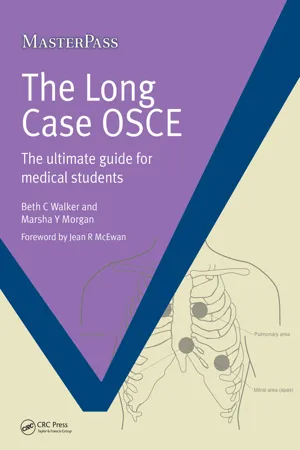
The Long Case OSCE
The Ultimate Guide for Medical Students
- 248 pages
- English
- ePUB (mobile friendly)
- Available on iOS & Android
The Long Case OSCE
The Ultimate Guide for Medical Students
About this book
A solid knowledge base and good clinical skills don't necessarily guarantee examination success in the long case OSCE. This book is the ultimate guide for medical students needing to combine their knowledge and skills with an ability to interpret the clinical findings, the proficiency to present them clearly and the confidence to deal with the examiners questions.
Adopting a proven, highly effective approach, this revision aid uses role play with simulated patients to hone clinical examination and presentation skills. The fifty cases are divided into six areas: cardiology, respiratory, abdomen, neurology, musculoskeletal and surgery.
Written by successful candidates and examiners, the guide poses a number of important and commonly asked examination questions for each case to assist in preparation and confidence, and model answers are provided to ensure an understanding of exactly what is required.
Working in groups or independently, students will welcome the large, colourful format, the breakdown of marking schemes, an overview of examiners expectations, a guide to presenting clinical findings and innumerable 'insider' tips throughout.
See accompanying video here: https://www.youtube.com/watch?v=Cvr4y-NykUU
Frequently asked questions
- Essential is ideal for learners and professionals who enjoy exploring a wide range of subjects. Access the Essential Library with 800,000+ trusted titles and best-sellers across business, personal growth, and the humanities. Includes unlimited reading time and Standard Read Aloud voice.
- Complete: Perfect for advanced learners and researchers needing full, unrestricted access. Unlock 1.4M+ books across hundreds of subjects, including academic and specialized titles. The Complete Plan also includes advanced features like Premium Read Aloud and Research Assistant.
Please note we cannot support devices running on iOS 13 and Android 7 or earlier. Learn more about using the app.
Information
CHAPTER 1
Cardiology Station
Cases 1–9
The secret of getting ahead is getting started.Mark Twain (1835–1910)
Cardiology Examination Example Marking Scheme
BEFORE STARTING
PERIPHERAL EXAMINATION










EXAMINATION OF THE PRAECORDIUM
Inspection

Palpation
Auscultation

Table of contents
- Cover
- Title Page
- Copyright Page
- Table of Contents
- Foreword
- Preface
- Acknowledgements
- Dedication
- List of Abbreviations
- About this Book
- How to Use this Book
- Ten Top Tips for the Long Case OSCE
- Presenting your Findings
- CHAPTER 1 Cardiology Station
- CHAPTER 2 Respiratory Station
- CHAPTER 3 Abdominal Station
- CHAPTER 4 Neurology Station
- CHAPTER 5 Musculoskeletal Station
- CHAPTER 6 Surgical Station